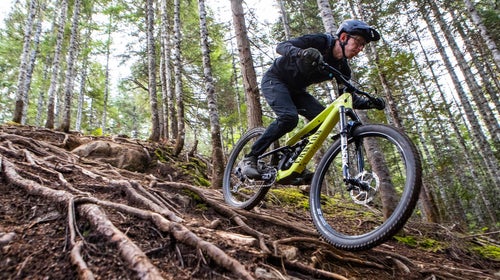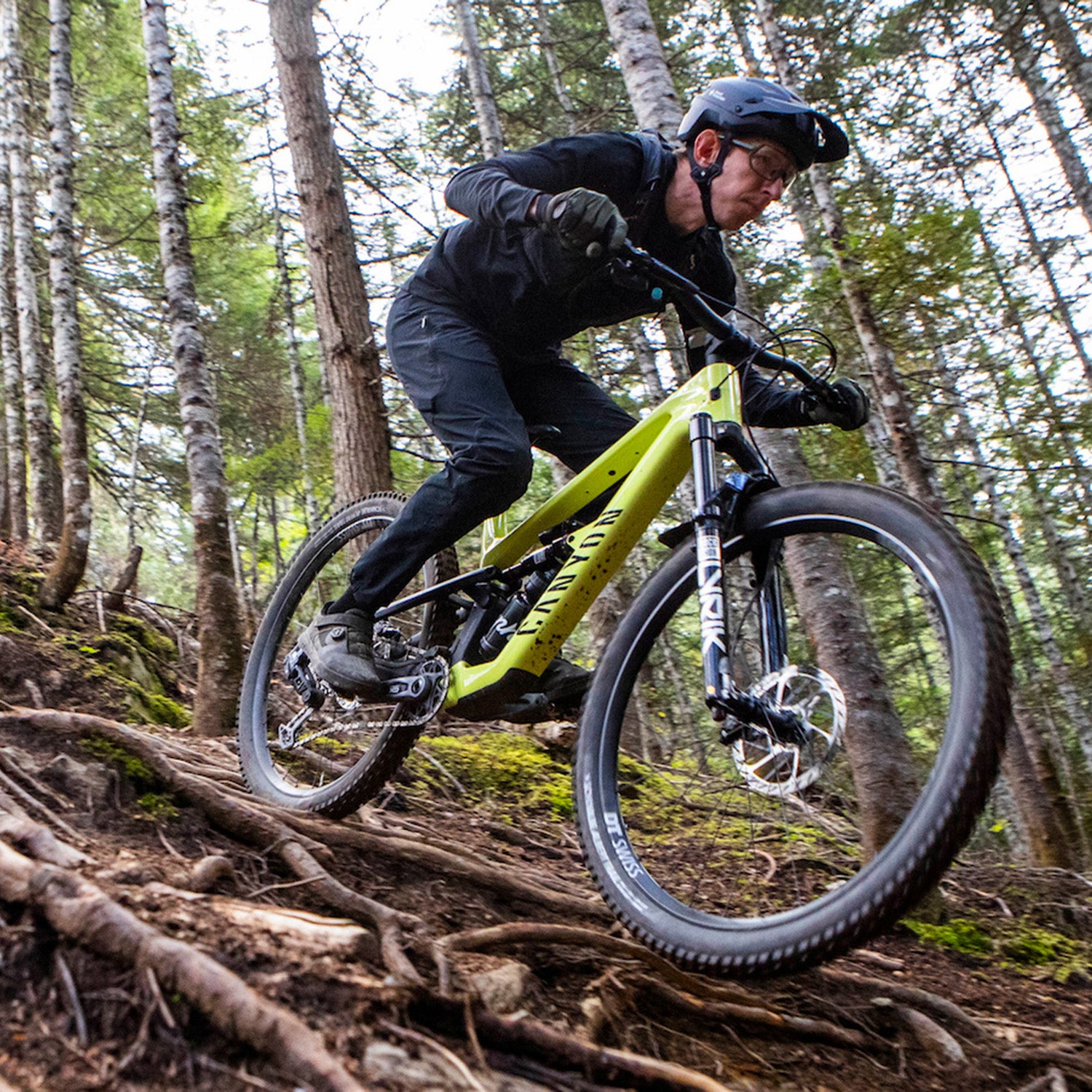This year’s round-up of trail mountain bikes ranges from hard-charging, downhill-oriented crushers to more cross-country-style rippers. Our testers and Pinkbike editors tested 25 trail bikes in the category from Bellingham to Squamish, in all kinds of conditions. After months of testing, these picks are the ones that came out on top.
Updated May 2025: We added three new bikes to this list for 2025, including our new Editors’ Choice pick, the Canyon Spectral. We also updated pricing and info on bikes we previously tested and still highly recommend.
Best Trail Mountain Bikes at a Glance
- Editors’ Choice: Canyon Spectral ($5,499)
- Best Adjustability: Trek Top Fuel ($11,550)
- Best Value: Specialized Stumpjumper 15 ($4,500)
- Best Descender: Scor 2030 GX ($6,499)
- Best High-Pivot: Forbidden Druid ($7,199)
- Most Versatile: Cannondale Habit Carbon LT 1 ($5,550)
- Best for Getting Air: Commencal Tempo LTD ($4,900)
- How to Choose a Trail Mountain Bike
- How We Test Trail Bikes
- Meet the Lead Testers
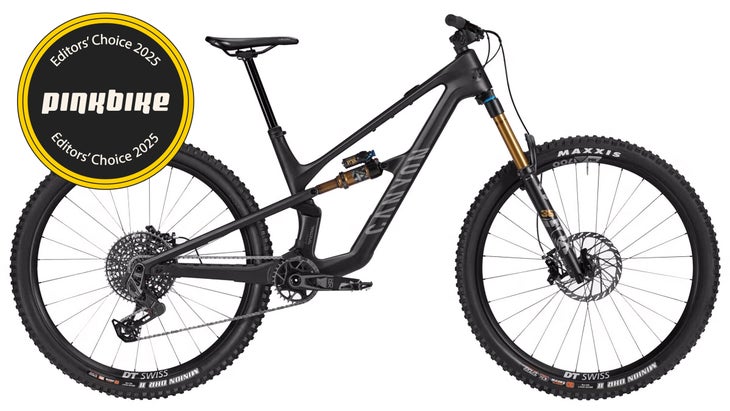
Editors’ Choice
Canyon Spectral
Build: CF9
Weight: 32.4 lb (size M)
Travel: 140 mm rear, 150 mm fork
Frame: Carbon
Wheels: 29″
Pros and Cons
⊕ Versatile
⊕ Good value
⊕ Supportive suspension
⊗ Not a lot of room for a water bottle
Canyon’s goal with the latest version of the Spectral was to make it more of an all-around trail bike, as opposed to an all-mountain rig. As we’ve established, mountain bike categories are harder to define than ever, but to accomplish that goal, Canyon reduced the rear travel by 10 millimeters, dropping it to 140 millimeters, and equipped the bike with a 150-millimeter fork. The bike can be set up with dual 29-inch wheels (the way we tested it) or with mixed wheels, thanks to a flip chip on the chainstay. Other than the change in rear travel, the other main revision to the Spectral was the addition of in-frame storage. It’s not the roomiest compartment out there, but it’s a handy spot to stash a tube, tire levers, and a CO2 inflator just in case.
The new Spectral has the snappy, energetic manners that you’d hope to find in a trail bike. Step on the pedals and it happily surges forward—there isn’t any wallowing down or sluggishness. The head angle is on the slacker side, but that didn’t seem to hinder its uphill abilities.
Rather than feeling like a slightly shorter travel enduro bike, the Spectral feels at home on a broader range of trails. It’s just as entertaining to ride on smooth, flowy singletrack as it is on tighter, jankier trails. The suspension sits high when you want it to, but still provides enough traction to keep that rear wheel tracking on choppier climbs.
The supportive suspension that helps the Spectral shine on the climbs translates very nicely to the descents—it was a crowd pleaser on faster, flowier trails, where you could really push it into steep bermed turns and pump every roller to for maximum speed. On rougher, natural tracks, the fact that there’s less travel than bikes like the Santa Cruz Bronson is noticeable, but it never felt chattery or overwhelmed. Even without a hydraulic bottom-out feature on the shock, there weren’t any harsh bottom-out events, and it saw its fair share of sizeable sends.
Yes, you’ll feel more feedback compared to those longer travel options, but the Spectral does a very good job of managing its travel. Smack into something hard and it’s like punching a memory foam mattress. The Spectral is one of those bikes that’s easy to recommend to just about any rider, no matter their skill level. It’s tons of fun on mellower, more meandering terrain, and it can still hang on rougher, rowdier trails. It’s a versatile trail bike that left us impressed by its unflappable nature in a wide variety of terrain.
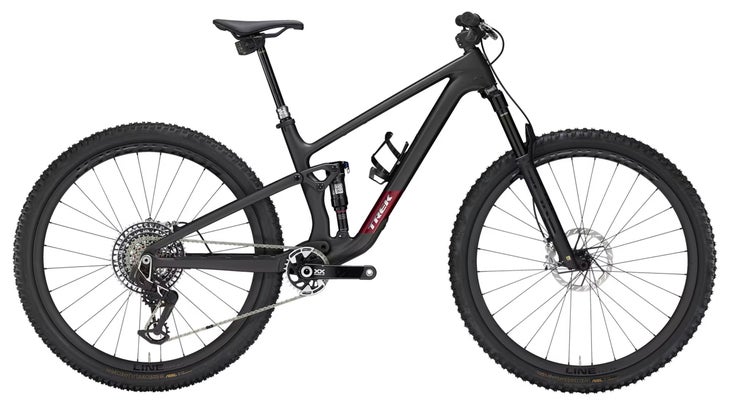
Best Adjustability
Trek Top Fuel
Build: 9.9 XX AXS
Weight: 28.2 lbs (size L)
Travel: 120 mm, 130 mm fork
Frame: Carbon
Wheels: 29″ (MX compatible with 140 mm fork)
Pros and Cons
⊕ Wide range of adjustment
⊕ Clean-looking frame
⊕ All modern amenities included
⊗ Underpowered brakes
⊗ Should be lighter for the price
It’s easy to obsess over a bike’s actual weight, but there’s something to be said about how a bike feels out on the trail. With the Top Fuel, it feels fast and eager to accelerate, even with tires and wheels that aren’t all that light. The Top Fuel manages to be quick and efficient without any harshness, a feat that’s not easy to accomplish. The suspension remains calm under harder pedaling, while retaining enough compliance to keep chunkier climbs from feeling jarring.
The geometry is nicely balanced, too: the chainstay length and overall wheelbase have grown compared to the last model, but if anything, I’d say that improves the bike’s handling while climbing and descending. On the climbs, it helps create a more centered position, which makes it easier to maintain traction on steep sections or to pause for a brief trackstand in the middle of a particularly tricky jumble of roots.
With the Top Fuel Gen 4, when the trail points downhill, the handling is quick without feeling sketchy. It’s right at home on rolling, meandering trails, and it does a great job of maintaining speed on descents that require pumping and pedaling to avoid getting hung up. Just like on the climbs, there’s support for those moments when an extra pedal stroke or two is required, and enough small bump sensitivity to keep the wheels gripping on slippery, awkward sections of trail.
At its core, the Top Fuel is a truly excellent bike, a prime example of how well-rounded a modern trail bike can be. Sure, it’s not as light as it once was, and there are a few spec choices that could be improved, but the ride quality and sheer number of possible configurations help make up for that. For riders on the hunt for a bike they can customize to perfectly suit their favorite local trails, the Top Fuel is well worth considering.
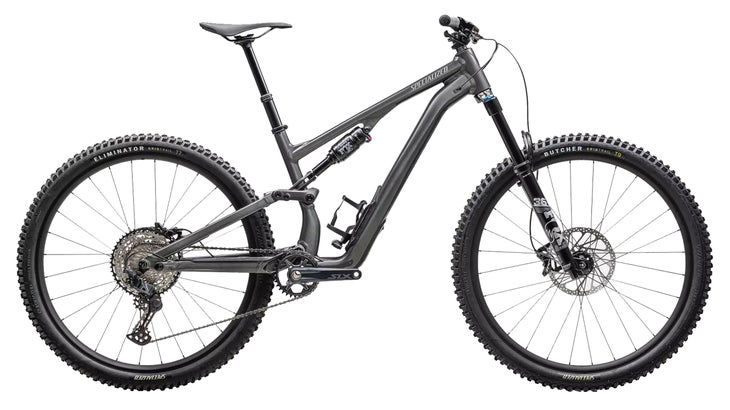
Best Value Trail Bike
Specialized Stumpjumper 15
Build: Comp Alloy
Weight: 36 lbs (s4)
Travel: 145 mm, 150 mm fork
Frame: Aluminum frame
Wheels: 29″ or MX
Pros and Cons
⊕ Sensitive suspension
⊕ Extensive adjustment capabilities
⊕ Descends like a bigger bike
⊗ Heavy
The Stumpjumper is Specialized’s now ubiquitous do-everything trail bike, with adjustability and adaptability integral to the bike’s character. This year’s update to the 15th iteration of the bike wasn’t some massive overhaul, but more of a refinement, with very similar geometry to the outgoing Stumpjumper EVO, and the introduction of the Genie shock. While not necessarily required, this shock is core to the bike’s purported improvement in suspension performance, and does achieve some impressive marks on paper.
The Stumpy’s ability to hum through rough and technical terrain is very impressive, thanks in part to its active suspension feel. Rear wheel traction is plentiful, meaning you can focus on putting down power without worrying about spinning out when things get tricky.
As terrain smooths out and climbs hit a more consistent gradient, the Stumpjumper 15 isn’t the most energetic of the bunch, due more to the active suspension and slack seat angle. Those looking to maximize the pep in the new Stumpjumper platform would benefit from adding more spacers to the Genie to reduce the extra volume and add some support through the main portion of the stroke. There’s a tradeoff with grip, but that’s to be expected.
The Stumpjumper 15 shines brightest in its stock setup, with the neutral headset orientation and high bottom bracket setting. No painting yourself into a corner—this is simply where the Stumpy feels most adaptable and ready to tackle varied terrain.
The geometry and corresponding handling of the bike feels natural, intuitive, and well-rounded, which lends itself to the varied riding one might expect to do on a capable trail bike. A few of us regularly referred to the bike as “safe” feeling, thanks to an easygoing nature that managed to extend even into some pretty gnarly sections of trail.
The Stumpjumper 15 should work well for new riders and experienced folks alike, growing with that skillset and adapting well to changes in terrain.
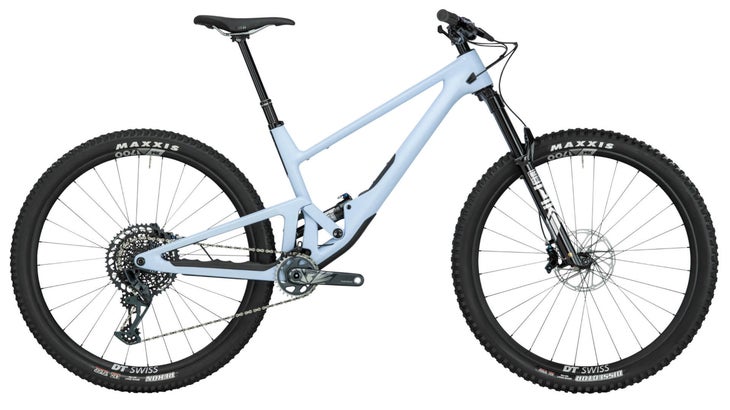
Best Descender
Scor 2030 GX
Build: 2030 GX
Weight: 29.9 lbs (size M/L)
Travel: 120 mm, 140 mm fork
Frame: Carbon
Wheels: 29″
Pros and Cons
⊕ It’s a better descender than most 120-millimeter travel bikes
⊕ Very quiet, no cable rattle or excessive chainslap
⊗ Your enduro bike might start collecting dust
It only takes one three-letter word to summarize why the Scor 2030 is our 2024 Editor’s Choice winner: FUN. With its stubby back end and relatively slack head angle, the 2030 is incredibly entertaining, especially on technical, rolling terrain. Pumping, manualing, and jumping are the 2030’s strong suits, but it also squeezes every last drop of performance out of its 120 millimeters of rear travel. That trait allows it to shine brighter than most bikes in this travel bracket when faced with chunky, technical sections of trail.
The 2030 is more focused on the descents than some other bikes in this category (like the Yeti SB120), but Scor’s designers didn’t forget that it needs to go uphill, too. It’s an energetic pedaler, free of any wallowing or mushiness while still delivering enough traction to keep that low-profile Rekon tire from spinning wildly. The perfect balance between efficiency and grip can be tricky to achieve, but the 2030 does it very well. It has the quickness you’d hope to get from a 120-millimeter bike without any accompanying harshness.
The geometry plays a large part in how comfortable the bike feels in the steeps, but the suspension deserves a mention, too: the Deluxe Ultimate shock is very well controlled, with a smooth ramp up at the bottom of the stroke. It’s a trait we noticed with the Scor 4060 a couple of years ago—there’s no harshness towards the end of the travel, which makes it easier to plop off a drop or push through a pointy rock garden without worrying about running out of travel.
Yes, there are limits—we’re still talking about a 120-millimeter trail bike here—and I’m not about to say it can go wheel-to-wheel with a full-on enduro bike. However, the fact that it can handle those more technical trails while also remaining entertaining on mellower ones is worth noting. The suspension opens up nicely at higher speeds, and it can deal with quick impacts very well.
The frame itself ticks all the boxes when it comes to the features we’d expect to see on a modern trail bike—there’s in-frame storage, angle-adjusting headset cups, well-sealed bearings, and effective chainslap protection that keeps the 2030 satisfyingly silent. The 2030 is one of those bikes that makes you want to keep on riding, sneaking in as many miles as possible before it’s time to return to reality.

Best High-Pivot Trail Bike
Forbidden Druid V2
Build: GX FX
Weight: 32.4 lbs (size M)
Travel: 130 mm, 150 mm fork
Frame: Carbon
Wheels: 29″ or MX
Pros and Cons
⊕ Descends like a longer travel bike
⊕ Extremely quiet ride
⊗ The extra idler wheel can require more servicing
⊗ A unique spin on geometry means the XL frame’s chainstay grows extremely long through the travel
If you’ve ever ridden an idler-equipped high-pivot bike—meaning the bike’s main pivot is placed above the top of the chainring and the rear wheel axle—you know the calming effect that the rearward axle path brings to the nature of the ride. Forbidden has taken that to a trail bike, something seldom utilized on a 130-millimeter-travel bike. The original Druid won over fans of shorter travel bikes with its ability to handle descents as if it had magical powers—now, it’s transcendent. Even with a longer-travel model in the lineup, Forbidden’s enduro racer, Rhys Verner, claimed the top spot this season aboard the Druid V2.
We took the Druid V2 out on singletrack uphills and downhills with chunky rock outcrops, and the bike felt superbly balanced. Thanks to the high pivot design and the Super Deluxe rear shock, the Druid handled technical bumps with ease and had no trouble carrying speed. The Druid V2 thrives in singletrack because you can stay seated upright and comfy, and you don’t lose much speed when pedaling across roots.
However, the admirable suspension qualities of high-pivot bikes don’t come easily—they typically require more upkeep to maintain maximum drivetrain efficiency. Due to the precise placements of the pivots on the Druid V2, you cannot adjust the geometry. To pick between a 64 or 64.5-degree head tube angle, you’ll need to choose the specific frame member that houses either a 27.5 or 29-inch rear wheel. Although the brake line’s routing passes through the seatstay, it’s not a swap you’ll be making in the parking lot. On that note of chainstays, Forbidden scales their front to rear center lengths proportionally per size, so the same ratio is kept on all frame sizes. Even taller riders may have trouble wielding the 466-millimeter chainstay found on the XL frame size.
Overall, the Druid V2 is one of the more capable short-travel bikes for riders who prefer snappy handling. It might take a while for some riders to acclimatize to its lengthy rear triangle, but the unbelievably smooth descent is worth it.
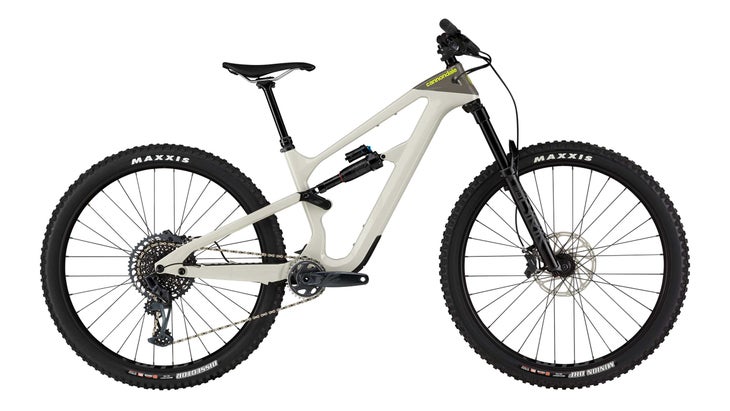
Most Versatile
Cannondale Habit Carbon LT 1
$4,000 at REI $4,000 at Jenson
Build: Sram GX Eagle
Weight: 31.4 lbs (size L)
Pros and Cons
⊕ Balanced and composed in tricky situations
⊗ Not super efficient on the uphill
When we covered the release of the Habit, it struck us just how sensible and conventional it was. There was no quirkiness to it, at least on the surface, and everything about it seemed to be pragmatic and well-judged. The Habit LT’s geometry, frame features, and simple layout all scream modern, sensible trail bike. The frame has some nice subtle features, with a rubber cover to stop your chainstay from gobbling up rocks, non-guided routing that is very easy to work with thanks to a removable panel on the downtube, ISCG threads, and a tried-and-true threaded bottom bracket.
Though it is a typical four-bar bike, the Habit has a comparatively low anti-squat value. This may be bad news for all-out efficiency on smooth roads, but it’s good news if you need your suspension to adapt to terrain on rougher climbs. The Habit is comfortable on undulating terrain thanks to that higher stack, and the suspension tracks and grips well. We sometimes used the climb switch for hard-pack fire roads or tarmac stretches, but for anything remotely rough, we set it to open and let it flow. It might not be the most suited to out-of-the-saddle pedaling hard, but the bike does strike a great balance between tracking and efficiency. The Habit LT is weighted on the front, balanced on most trails, and able to handle very steep trails because of this well-proportioned and pragmatic geometry. We’re not big believers in massive reaches, especially when combined with short rear ends—the grip the Habit achieves on any type of trail is a testament to this. Extra-regular is no bad thing.
Overall, this is a very well-executed bike that simply works very well. Balance, composure, maneuverability, and comfort can oftentimes seem like ideologies that are opposed to one another in bikes, and you can merely have two or three out of the four at best. The Habit LT makes a very strong argument that, as riders, we might just be able to have it all.
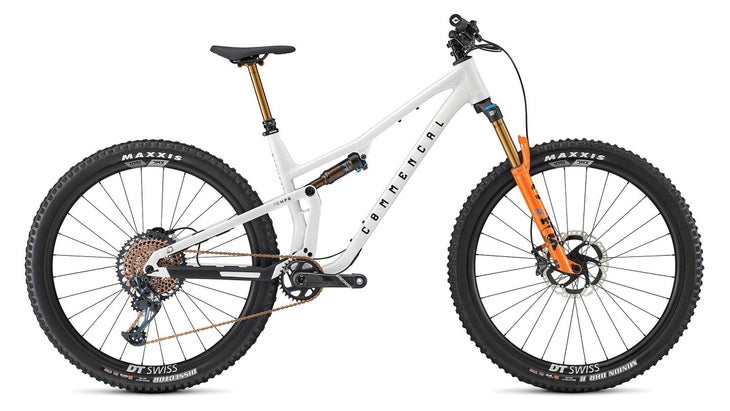
Best for Getting Air
Commencal Tempo LTD
Build: Tempo LTD
Weight: 30.9 lbs (size S)
Travel: 125 mm rear, 140 mm fork
Frame: Aluminum
Wheels: 29″
Pros and Cons
⊕ Quick and lively
⊕ Never met a jump or corner it didn’t like
⊗ Thru-headset cable routing can make maintenance more difficult
No matter which direction the trail points, the Tempo is fast. It has a satisfying snappiness that rewards hard pedaling efforts, especially on rolling terrain where the bike can be pumped and pushed to maintain that momentum. It’s also a very energetic climber, which will be a welcome trait to anyone coming off of a longer travel machine with more subdued pedaling manners. Compared to longer, slacker bikes where you need to swing wide to navigate awkward switchbacks, the Tempo is happiest taking the inside line, following a tight, precise arc on its way upwards. We’d be tempted to call it a trail bike for riders who prioritize the climbs—except that it’s a blast on the downhills too.
The Tempo is the type of bike that can breathe new life into mellower trails while also holding its own on the rowdier stuff. Modern mountain bike categories can be nebulous at times, but this is a trail bike in the truest sense of the term, well-suited to spinning out the miles while also goofing off and hitting every lip and landing possible. Do we wish it didn’t have thru-headset cable routing and better-sealed frame bearings? You bet, but we wouldn’t consider either of those deal-breakers. The overall ride characteristics of the Tempo are overwhelmingly positive, enough so that we’d be willing to deal with a little extra shop time.
How to Choose a Trail Bike
The trail bike category is the most saturated in mountain biking, so it’s understandable if you’re feeling a bit overwhelmed. Fortunately, there are a few easy questions you can ask yourself to narrow the field.
What kind of riding will you be doing?
As much as you may want to answer this one with flowy, singletrack heaven, it’s important to be realistic about what you’ll actually be riding. This can be determined by the time of year that you mostly get out there (which will determine what the conditions will be like), which trails are most accessible to you, and which region you bike in. Are you planning on taking big trips consistently, or will you mostly stay local?
Will you be riding lift-accessed trails?
If most of the riding you’ll be doing is lift-accessed, you may want to look in the enduro category. If you’ll be doing a mix of both and are planning on hitting jumps, look for a bike that has enough travel but doesn’t compromise on the uphill either.
What’s your riding style?
If you prefer to charge through steep, technical sections, you could be looking at a very different bike than if you’re a more playful rider who likes to find side hits. Again, be honest with yourself about this. How do you actually ride, and what’s aspirational?
What’s your budget?
Yes, mountain bikes are expensive. But you do have options. Consider buying used (the market has finally gotten more reasonable this past year), by checking out Pinkbike’s marketplace or looking on Craigslist. Or, check out our best value bikes page for cheaper new bikes. If you’re thinking about buying a used bike (which can be an excellent option), watch this video from Pinkbike Originals.
Are you able to test it out?
You must take a bike at least for a spin around the block before you pull the trigger. You might find that you’re uncomfortable on a bike with a certain geometry that you’re not used to—and although sometimes it does take some more time on the bike—you’ll know if you’re just not sitting right. Taking it for a spin will also help the shop determine which size is best for you.
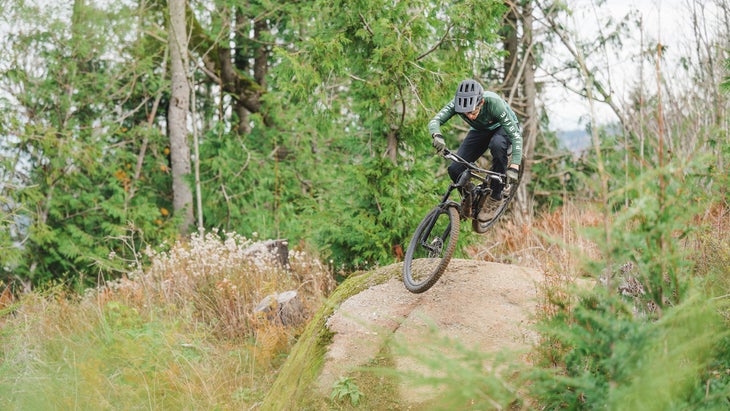
How We Test Trail Bikes
- Number of Testers: 6
- Number of Products Tested: 25
Pinkbike leads our mountain bike testing and just like in previous years, the team took out as many trail bikes as they could over the whole year. They tested trail bikes in Bellingham, Washington, and Squamish, BC, in a wide range of conditions that included everything from muddy, rainy days to ones with blue skies and perfect dirt. Testing was lead by Mike Kazimer, Pinkbike’s editor in chief, who is based in Bellingham, Washington and manages all mountain bike gear coverage.
Meet Our Lead Testers
Mike Kazimer
Mike Kazimer is Pinkbike’s editor-in-chief, and has been entrenched in the mountain bike world for well over 20 years. From crushing cardboard boxes as a shop grom to his current role as Pinkbike, he’s long been fascinated with the elegant simplicity of human powered machines. Based in Bellingham, Washington, Kazimer’s no stranger to wet weather, and his favorite rides tend to be long, technical forays deep into the forest.
Dario DiGullio
Dario DiGiulio is a tech editor for Pinkbike. You can find him biking the trails of Bellingham, Washington year-round.
Matt Beer
Matt Beer is a tech editor for Pinkbike. He’s based in Squamish, B.C.
More Gear Reviews
The Best Bike Helmets
The Best Action Cameras of 2025
The Best Enduro Bikes
